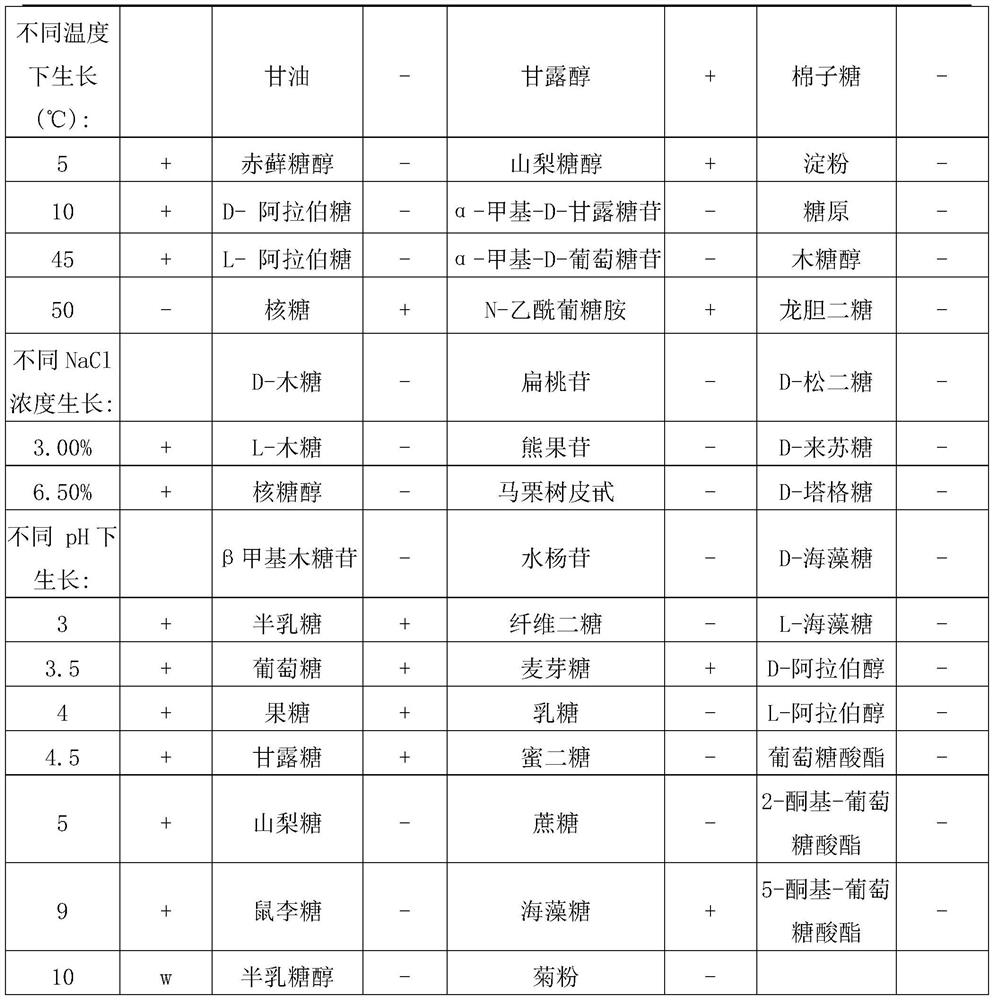Salt-resistant and low-temperature-resistant lactobacillus curvatus for inhibiting pathogenic bacteria and application of lactobacillus curvatus in cold-chain repeated freezing and thawing preservation of food
A technology of repeated freezing and thawing and pathogenic bacteria, applied in food preservation, application, bacteria, etc., can solve problems such as food quality decline and safety hazards
- Summary
- Abstract
- Description
- Claims
- Application Information
AI Technical Summary
Problems solved by technology
Method used
Image
Examples
Embodiment 1
[0050] Example 1, Isolation and identification of lactic acid bacteria strain Lactobacillus curvatus QZ 2195
[0051] 1. Separation and purification
[0052] The strain QZ2195 was isolated from fresh wheat materials in Qinghai. The specific method is as follows:
[0053] Weigh 5 g of fresh sample and add it into 45 ml of sterilized distilled water, shake it with a vortex oscillator for 30 s, dilute it 5 times sequentially according to a 10-fold gradient, and then take 20 μl each of the 10, 1000 and 100000-fold diluted sample solution and spread it on the MRS medium Place it in an anaerobic incubator and cultivate it for 24 hours to isolate and further purify to obtain QZ2195, which is a Gram-positive bacillus, negative for catalase, and does not produce spores.
[0054] 2. Physiological, biochemical and molecular identification
[0055] 1. Physiological and biochemical identification
[0056] The above strain QZ2195 was grown under different conditions and API50 was used to...
Embodiment 2
[0072] Example 2. Application of Lactobacillus curvatus QZ2195 in Food Cold Chain Repeated Freezing-Thawing Preservation 1. High Salt Resistance Experiment of Lactobacillus curvatus QZ2195
[0073] Cultivate the QZ2195 of Example 1 in the MRS liquid medium at 30°C until the number of viable bacteria is 10 8 Cfu / mL or more, remove the supernatant, add 1 mL of sterile NaCl solution (solvent is water) shown in Table 3 for 3 hours, and then culture anaerobically on the MRS solid plate at 28°C for 24 hours.
[0074] The results are shown in Table 3. The survival rate of Lactobacillus curvatus QZ2195 reached over 90% after 3 hours in 20% NaCl solution, indicating that it is resistant to high salt.
[0075] Table 3 is the survival rate of bacterial strains under different salt concentrations
[0076]
[0077]
[0078] 2. Drug susceptibility test of Lactobacillus curvatus QZ2195
[0079] The QZ2195 in Example 1 was cultured in MRS liquid medium (without agar) at 30° C. for 24 ...
Embodiment 3
[0109] Embodiment 3, Lactobacillus curvatus QZ 2195 are to the preservation of frozen food products under repeated freezing and thawing
[0110] Lactobacillus curvatus QZ2195 was cultured in MRS liquid medium at 28°C for 24 hours, centrifuged at 5000 rpm, and the supernatant was taken.
[0111] Soak the various frozen food products shown in Table 8 with the above supernatant for 10 minutes, take them out, and preserve them for 15 days under the following conditions: repeated freezing at 25°C, 4°C, -4°C, -7°C and 7°C Melt for 5 rounds, with no soaking treatment as the control.
[0112]To observe the state of frozen food, weigh 5g and add it to 45ml of sterilized distilled water, shake it with a vortex oscillator for 30s, and dilute it 5 times sequentially according to a 10-fold gradient, then take 20μl each of the 10, 1,000, and 100,000-fold diluted sample solutions, respectively. Blue solid medium at 28°C, cultured for 24 hours to detect Escherichia coli; on NA solid plate at...
PUM
 Login to View More
Login to View More Abstract
Description
Claims
Application Information
 Login to View More
Login to View More - Generate Ideas
- Intellectual Property
- Life Sciences
- Materials
- Tech Scout
- Unparalleled Data Quality
- Higher Quality Content
- 60% Fewer Hallucinations
Browse by: Latest US Patents, China's latest patents, Technical Efficacy Thesaurus, Application Domain, Technology Topic, Popular Technical Reports.
© 2025 PatSnap. All rights reserved.Legal|Privacy policy|Modern Slavery Act Transparency Statement|Sitemap|About US| Contact US: help@patsnap.com



